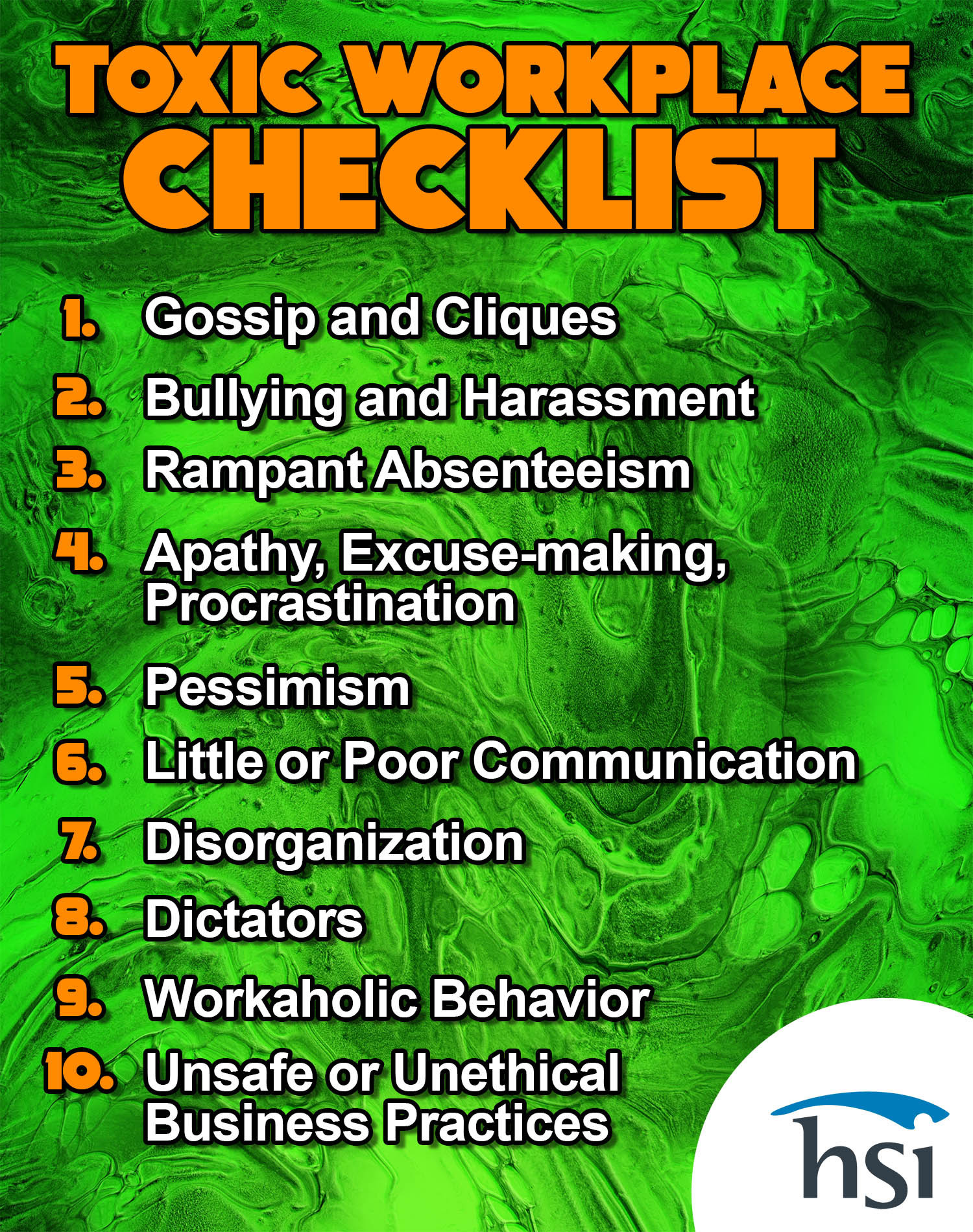10 Signs of a Toxic Workplace: A Checklist for Managers

With today’s labor shortage, organizations can’t afford to ignore the signs of a toxic workplace. This might be company-wide, or isolated to a specific department. As a manager, it’s your responsibility to do your best to create a safe, supportive, and productive environment. If you are reading this blog, your gut is telling you there might be toxic behaviors among your team members, and possibly, leadership and the entire organization. Our toxic workplace checklist can help you diagnose your issues. We will also provide a list of training topics to help you rid your business of toxicity, in whatever forms it might exist.
Toxic Workplace Checklist
Having worked in a toxic office with a bad manager years ago, I can empathize with your situation. I would never wish this on anyone. So, I commend you for researching solutions, and hopefully, our checklist below can help you identify these issues and make a real, positive impact on your department and company culture.

Among Employees
1. Gossip and Cliques
The first possible sign of a toxic workplace is when there is lots of gossiping or workplace cliques. It’s natural for employees to create friend groups, but when they become exclusive and divisive, it’s a problem. It should be addressed directly with the person or people you are concerned about.
In my experience, I bonded with my co-workers as we shared our stories of our toxic boss. It was almost like group therapy. Our gossip was not malicious, but it was definitely a sign of a bad manager and hostile work environment.
2. Bullying and Harassment
Other toxic workplace behaviors are bullying, harassment, and even sexual harassment. Unfortunately, not all this behavior is considered illegal. The law does not require bad bosses to be kind or supportive. Some toxic leaders use threats, insults, and intimidation as their means to “motivate” employees. If they don’t target their behavior and are equal-opportunity abusers, it’s legal.
My toxic manager threatened repeatedly to write me up when I was going above and beyond trying to meet their demands. Their demeanor would flip like a switch during a meeting, and they would go off on an angry tirade. Once, they threw a phone at an agency account manager! I reported the behavior to our HR department, but they were slow to react. I eventually left the company but, really, I left that one bad manager.
3. Rampant Absenteeism
A healthy company culture encourages employees to take vacation time to manage their mental health and work stress. HSI offers a very generous PTO policy because they value our health and wellness, and trust people to take the time they need. But if you are seeing high levels of absenteeism on a regular basis, this is a sign of toxic work culture, and a lack of work-life balance.
Toxicity can affect the physical health of your employees and be the cause of absenteeism. Personally, I had two different doctors talk to me about the effects of stress on my body. Good managers will recognize absenteeism as a warning sign, and work to make positive changes in the best interests of their team.
4. Apathy, Excuse-Making, Procrastination
Multiple missed deadlines, preventable mistakes, and a decrease in quality scores are signs you may have issues with apathy and procrastination. When you talk to your employees about the quality of their work overall, you may face a lack of remorse, weak excuses, or even silence.
Employees thrive in a healthy workplace. And healthy is defined here as providing the necessary training and motivation. Meanwhile, a toxic workplace will lack access to the training and professional development needed to help employees receive constructive feedback and take steps to improve.
5. Pessimism
Employees in a toxic culture can feel beaten down by negative energy and negative people. It becomes easy to fall into pessimism and expect the worst. You may overhear people ridiculing the company mission, complaining about impossible timelines, or mocking the business leaders.
The longer the toxic environment remains status quo, pessimism will continue to fester and negatively affect employee engagement. In my experience, the harder I tried and the longer hours I worked never seemed to matter to my abusive supervisor. It was impossible to avoid pessimism.
Among Managers
6. Little or Poor Communication
A common complaint in employee surveys is a lack of transparency and communication from senior leadership. I once worked with a small group of executives who would not respond to an email, voicemail, or meeting invite from anyone without a VP title. This problem is exacerbated in toxic workplace culture. What are the company’s goals? How important is each employee’s role in achieving those goals? How do leaders support the employees? How is the company doing towards achieving those goals? When employees know these things, it engages and motivates them.
A healthy work environment is fueled by effective communication from managers. It can be frustrating and distracting to employees when they are blindsided by changes in policies and processes, or simply kept out of the loop. Companies should make internal communications a priority and have a plan to cascade news and announcements throughout the organization.
7. Disorganization
Disorganization is a symptom of poor change management and poor project management. Disorder at the top causes chaos and heavier workloads for the employees. It also fuels the overall toxic environment.
A common dysfunction of companies is when they are divided by siloed departments, trying to run independently, and not sharing information, decisions, or project plans. This kind of behavior is an indicator of the company’s culture and core values, directly affecting employee engagement.
8. Dictators
Another sign of a toxic workplace is the poor leadership of dictators in managerial roles. They are driven by their ego and often try to orchestrate everything themselves. They try to micromanage all aspects of your work. Their lack of trust can cause low morale and high turnover rates.
Dictators also stifle creativity and innovation. They slow progress and hinder productivity. As a manager, you need a high level of self-awareness and emotional intelligence to recognize your own leadership style, weaknesses, and areas that need improvement. And if you tend toward dictatorial methods, it is critical that you catch and fix those behaviors.
9. Workaholic Behavior
There is a natural ebb and flow to most normal work. We all have busy times and heavier workloads at certain times of the year. A workaholic drives a workload that requires longer hours and constant pressure as the norm. They don’t value work-life balance and they don’t care about your personal time.
In my case, the toxic person was my department head, and the workaholic expectations were limited to our department. I would go to the office at 7:00 a.m. and work until 6:00 p.m., then head home and work for another couple hours each night, and it still wasn’t enough. My typical working day was 12-14 hours. That’s not sustainable. Add in some verbal abuse, and it was evident I needed to create an escape plan and find a new job.
10. Unsafe or Unethical Business Practices
The final sign of toxicity that stems from management is unsafe or unethical business practices. An example might be if you observe deception in how key metrics are reported or manipulated. Or maybe a decision is made to reduce cleaning or maintenance practices to save on expenses.
I once observed a senior executive’s behavior become more volatile every day after lunch. Any afternoon meeting was left with indecision and uncertainty because of their behavior. I confided in a trusted co-worker that I thought this person was abusing drugs or alcohol at lunch. The leader was at the center of the inner circle of executives, and we feared the consequences of our accusation, so we never raised the issue.
Training Topics to Alleviate a Toxic Culture
So, whether you are a manager who made a bad hire and the new employee has brought negative energy to the group, or you are a department-head who recognizes toxic behavior in your team, or you are a senior executive wanting to change the workplace culture, training from HSI can help.
HSI’s employee training and development solutions can offer you a wide selection of courses for any of your current and future needs. When you work with a company like HSI, and utilize our off-the-shelf library of business skills programs, you could easily curate a curriculum to help your team deal with and even eliminate toxic behaviors. You can custom-fit your training, choosing from courses and series that include the following:
- The Toxic Work Environment
- Dealing With Difficult Co-workers
- Stopping the Drama
- Workplace Bullying
- Understanding Harassment
- How to Finish What You Start
- Time Management
- Healthy Communication
- Concerned Conversations
- Change Management
- Project Management
- Creating a Culture of Transparency
- Organizational Dysfunction
- Ethics for Managers and Employees
You can download the Business Skills library here. Learn more about HSI's employee training and development solution and the courses we offer that can help you avoid a toxic workplace.


